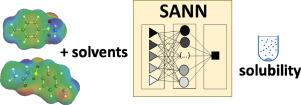当前位置:
X-MOL 学术
›
Fluid Phase Equilibr.
›
论文详情
Our official English website, www.x-mol.net, welcomes your
feedback! (Note: you will need to create a separate account there.)
Solubility of Sulfanilamide and Sulfacetamide in neat solvents: measurements and interpretation using theoretical predictive models, first principle approach and artificial neural networks
Fluid Phase Equilibria ( IF 2.8 ) Pub Date : 2021-02-01 , DOI: 10.1016/j.fluid.2020.112883 Piotr Cysewski , Tomasz Jeliński , Dominika Procek , Aleksandra Dratwa
Fluid Phase Equilibria ( IF 2.8 ) Pub Date : 2021-02-01 , DOI: 10.1016/j.fluid.2020.112883 Piotr Cysewski , Tomasz Jeliński , Dominika Procek , Aleksandra Dratwa

|
Abstract Solubilities of Sulfanilamide and Sulfacetamide in neat solvents were both measured and collected from the literature. The set comprising 35 systems was interpreted in terms of the empirical and semi-empirical predictive models including Buchowski-Ksiazczak model (λh-equation), extended Buchowski's model (λβ-equation), modified Apelblat equation, van't Hoff-Yaws model, Non-Random Two Liquid (NRTL) model, Wilson model and the Weibull two-parameter extrapolation model. The advantage of corrected Akaike information criterion was used for precise quantification of the quality of each model. It turned out that the lowest values of this measure were found for the Buchowski-Ksiazczak approach indicating the best correlation with experimental solubility data. Interestingly, λβ-equation and van't Hoff–Yaws model give a fitting of almost the same quality but were slightly less accurate compared to λh-equation. The results of applied COSMO-RS computations suffered seriously from inaccuracies providing only a qualitative guess of solubility. Hence, machine learning procedure was applied for building a non-linear fully predictive model. The set of used molecular descriptors comes from COSMO-RS computations and characterizes intermolecular interactions in pure solvents. Based on the quality of obtained machine learning model it is possible to confirm that the selected set of descriptors can be used for solubility modeling and carries the most important information necessary for quantifying of saturated solutions.
中文翻译:

磺胺和磺胺乙酰胺在纯溶剂中的溶解度:使用理论预测模型、第一原理方法和人工神经网络进行测量和解释
摘要 磺胺和磺胺乙酰胺在纯溶剂中的溶解度都是从文献中测量和收集的。包含 35 个系统的集合根据经验和半经验预测模型进行解释,包括 Buchowski-Ksiazczak 模型(λh-方程)、扩展 Buchowski 模型(λβ-方程)、修正的 Apelblat 方程、van't Hoff-Yaws 模型、非随机二液体 (NRTL) 模型、Wilson 模型和 Weibull 两参数外推模型。利用校正Akaike信息准则的优势,对每个模型的质量进行精确量化。结果表明,Buchowski-Ksiazczak 方法发现了该测量的最低值,表明与实验溶解度数据的最佳相关性。有趣的是,λβ 方程和 van' t Hoff-Yaws 模型给出了几乎相同质量的拟合,但与 λh 方程相比精度稍低。应用 COSMO-RS 计算的结果严重不准确,只能提供溶解度的定性猜测。因此,机器学习程序被应用于构建非线性完全预测模型。使用的一组分子描述符来自 COSMO-RS 计算,并表征纯溶剂中的分子间相互作用。根据获得的机器学习模型的质量,可以确认所选的描述符集可用于溶解度建模,并携带量化饱和溶液所需的最重要信息。应用 COSMO-RS 计算的结果严重不准确,只能提供溶解度的定性猜测。因此,机器学习程序被应用于构建非线性完全预测模型。使用的分子描述符集来自 COSMO-RS 计算,并表征纯溶剂中的分子间相互作用。根据获得的机器学习模型的质量,可以确认所选的描述符集可用于溶解度建模,并携带量化饱和溶液所需的最重要信息。应用 COSMO-RS 计算的结果严重不准确,只能提供溶解度的定性猜测。因此,机器学习程序被应用于构建非线性完全预测模型。使用的一组分子描述符来自 COSMO-RS 计算,并表征纯溶剂中的分子间相互作用。根据获得的机器学习模型的质量,可以确认所选的描述符集可用于溶解度建模,并携带量化饱和溶液所需的最重要信息。使用的一组分子描述符来自 COSMO-RS 计算,并表征纯溶剂中的分子间相互作用。根据获得的机器学习模型的质量,可以确认所选的描述符集可用于溶解度建模,并携带量化饱和溶液所需的最重要信息。使用的一组分子描述符来自 COSMO-RS 计算,并表征纯溶剂中的分子间相互作用。根据获得的机器学习模型的质量,可以确认所选的描述符集可用于溶解度建模,并携带量化饱和溶液所需的最重要信息。
更新日期:2021-02-01
中文翻译:

磺胺和磺胺乙酰胺在纯溶剂中的溶解度:使用理论预测模型、第一原理方法和人工神经网络进行测量和解释
摘要 磺胺和磺胺乙酰胺在纯溶剂中的溶解度都是从文献中测量和收集的。包含 35 个系统的集合根据经验和半经验预测模型进行解释,包括 Buchowski-Ksiazczak 模型(λh-方程)、扩展 Buchowski 模型(λβ-方程)、修正的 Apelblat 方程、van't Hoff-Yaws 模型、非随机二液体 (NRTL) 模型、Wilson 模型和 Weibull 两参数外推模型。利用校正Akaike信息准则的优势,对每个模型的质量进行精确量化。结果表明,Buchowski-Ksiazczak 方法发现了该测量的最低值,表明与实验溶解度数据的最佳相关性。有趣的是,λβ 方程和 van' t Hoff-Yaws 模型给出了几乎相同质量的拟合,但与 λh 方程相比精度稍低。应用 COSMO-RS 计算的结果严重不准确,只能提供溶解度的定性猜测。因此,机器学习程序被应用于构建非线性完全预测模型。使用的一组分子描述符来自 COSMO-RS 计算,并表征纯溶剂中的分子间相互作用。根据获得的机器学习模型的质量,可以确认所选的描述符集可用于溶解度建模,并携带量化饱和溶液所需的最重要信息。应用 COSMO-RS 计算的结果严重不准确,只能提供溶解度的定性猜测。因此,机器学习程序被应用于构建非线性完全预测模型。使用的分子描述符集来自 COSMO-RS 计算,并表征纯溶剂中的分子间相互作用。根据获得的机器学习模型的质量,可以确认所选的描述符集可用于溶解度建模,并携带量化饱和溶液所需的最重要信息。应用 COSMO-RS 计算的结果严重不准确,只能提供溶解度的定性猜测。因此,机器学习程序被应用于构建非线性完全预测模型。使用的一组分子描述符来自 COSMO-RS 计算,并表征纯溶剂中的分子间相互作用。根据获得的机器学习模型的质量,可以确认所选的描述符集可用于溶解度建模,并携带量化饱和溶液所需的最重要信息。使用的一组分子描述符来自 COSMO-RS 计算,并表征纯溶剂中的分子间相互作用。根据获得的机器学习模型的质量,可以确认所选的描述符集可用于溶解度建模,并携带量化饱和溶液所需的最重要信息。使用的一组分子描述符来自 COSMO-RS 计算,并表征纯溶剂中的分子间相互作用。根据获得的机器学习模型的质量,可以确认所选的描述符集可用于溶解度建模,并携带量化饱和溶液所需的最重要信息。











































 京公网安备 11010802027423号
京公网安备 11010802027423号